Intel Ghost Canyon NUC9i9QNX Review: NUC 9 Extreme Realizes the SFF Dream
by Ganesh T S on April 16, 2020 8:05 AM ESTGPU Performance - Gaming Workloads
The gaming test suite for SFF PCs was revamped in mid-2018 with six different games:
- Civlization VI (DX12)
- Dota 2
- F1 2017
- Grand Theft Auto V
- Middle Earth: Shadow of War
- Far Cry 5
Most system reviews take a handful of games and process them at one resolution / quality settings for comparison purposes. Recently, we have seen many pre-built systems coming out with varying gaming capabilities. Hence, it has become imperative to give consumers an idea of how a given system performs over a range of resolutions and quality settings for each game. Our test suite is able to address this aspect.
Civilization VI (DX12)
The Civilization series of turn-based strategy games is very popular. For such games, the frame rate is not necessarily an important factor in the gaming experience. However, with Civilization VI, Firaxis has cranked up the visual fidelity to make the game more attractive. As a result, the game can be taxing on the GPU as well as the CPU, particularly in the DirectX 12 mode.
| Civilization VI (DirectX 12) Performance | |||
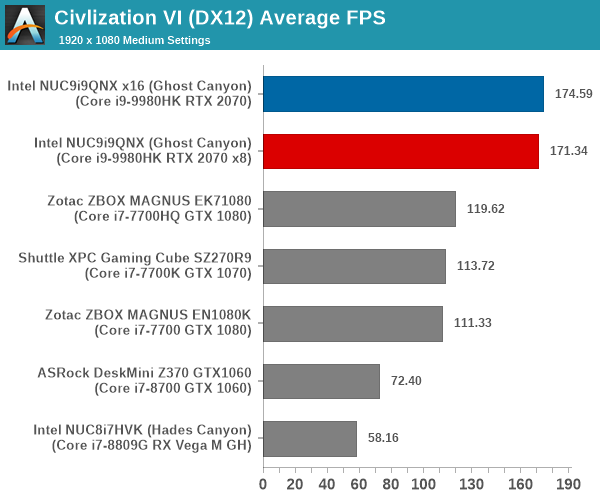
We processed the built-in benchmark at two different resolutions (1080p and 2160p), and with two different quality settings (medium and ultra, with the exact differences detailed here). There are no surprises here, with the RTX 2070 performing way better than the previous-generation GPUs. Operating the RTX 2070 in x16 mode results in slightly better performance (around 3 - 4 fps better, but very much dependent on the quality and resolution) compared to a x8 configuration
Dota 2
Dota 2 has been featuring in our mini-PC and notebook reviews for a few years now, but, it still continues to be a very relevant game. Our evaluation was limited to a custom replay file at 1080p resolution with enthusiast settings ('best-looking' preset). We have now revamped our testing to include multiple resolutions - This brings out the fact that the game is CPU-limited in many configurations.
Dota 2 allows for multiple renderers - we use the DirectX 11 mode. The rendering settings are set to 'enthusiast level' (best-looking, which has all options turned on, and at Ultra level, except for the Shadow Quality set to 'High'). We cycle through different resolutions after setting the monitor resolution to match the desired resolution. The core scripts and replay files are sourced from Jonathan Liebig's original Dota 2 benchmarking instructions which used a sequence of frames from Match 3061101068.
| Dota 2 - Enthusiast Quality Performance | |||
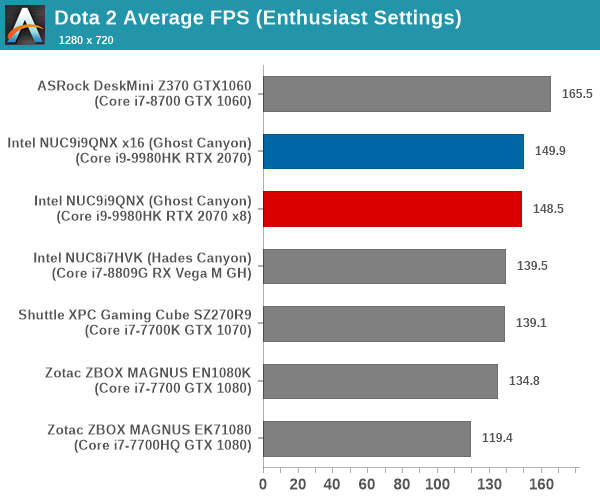
Due to the CPU-limited nature of the game, the Ghost Canyon NUC is not able to emerge as a clear winner here. However, the performance is more than enough to provide an excellent experience across all resolutions and quality settings for Dota 2.
F1 2017
Our gaming system reviews have always had a representative racing game in it. While our previous benchmark suite for PCs featured Dirt 2, we have moved on to the more recent F1 2017 from Codemasters for our revamp.
| F1 2017 - Ultra Quality Performance | |||
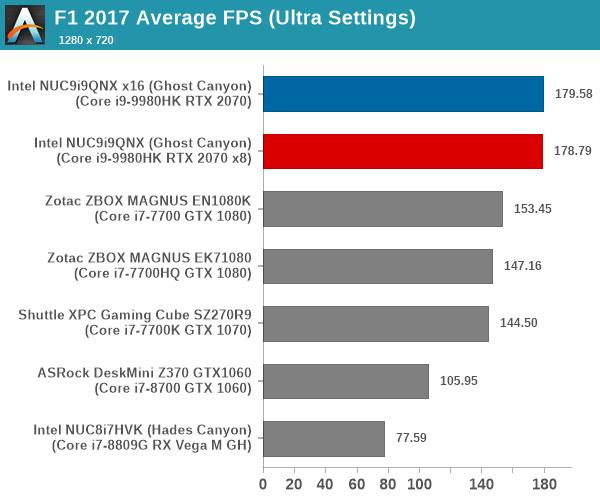
The supplied example benchmark (with some minor tweaks) is processed at four different resolutions while maintaining the graphics settings at the built-in 'Ultra' level.
Grand Theft Auto V
GTA doesn’t provide graphical presets, but opens up the options to users and extends the boundaries by pushing even the hardest systems to the limit using Rockstar’s Advanced Game Engine under DirectX 11. Whether the user is flying high in the mountains with long draw distances or dealing with assorted trash in the city, when cranked up to maximum it creates stunning visuals but hard work for both the CPU and the GPU. For our test we have scripted a version of the in-game benchmark. The in-game benchmark consists of five scenarios: four short panning shots with varying lighting and weather effects, and a fifth action sequence that lasts around 90 seconds. We use only the final part of the benchmark, which combines a flight scene in a jet followed by an inner city drive-by through several intersections followed by ramming a tanker that explodes, causing other cars to explode as well. This is a mix of distance rendering followed by a detailed near-rendering action sequence.
| Grand Theft Auto V Performance | |||
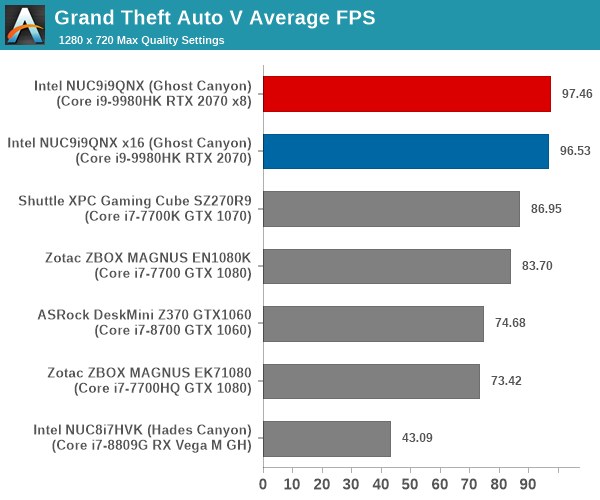
We processed the benchmark across various resolutions and quality settings (detailed here). The results are presented above.
Middle Earth: Shadow of War
Middle Earth: Shadow of War is an action RPG. In our previous gaming benchmarks suite, we used its prequel - Shadow of Mordor. Produced by Monolith and using the new LithTech Firebird engine and numerous detail add-ons, Shadow of War goes for detail and complexity. The graphics settings include standard options such as Graphical Quality, Lighting, Mesh, Motion Blur, Shadow Quality, Textures, Vegetation Range, Depth of Field, Transparency and Tessellation. There are standard presets as well. The game also includes a 'Dynamic Resolution' option that automatically alters graphics quality to hit a pre-set frame rate. We benchmarked the game at four different resolutions - 4K, 1440p, 1080p, and 720p. Two standard presets - Ultra and Medium - were used at each resolution after turning off the dynamic resolution option.
| Middle Earth: Shadow of War Performance | |||

While the Ghost Canyon NUC is the best of the lot, the interesting aspect to observe here is that x8 or x16 essentially makes no difference to the game's performance.
Far Cry 5
Ubisoft's Far Cry 5 is an action-adventure first-person shooter game released in March 2018. The game comes with an in-built benchmark and has standard pre-sets for quality settings. We benchmarked the game at four different resolutions - 720p, 1080p, 1440p, and 2160p. Two preset quality settings were processed at each resolution - normal and ultra.
| Far Cry 5 Performance | |||
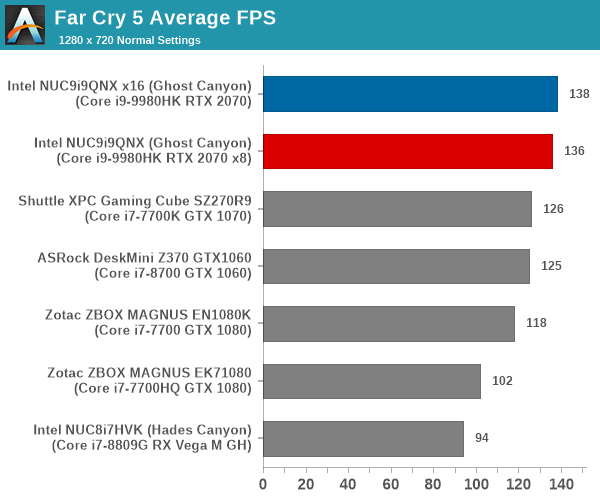
As expected, the Ghost Canyon NUC configuration performs much better than any of the other configurations in the list. The x16 mode delivers slightly more FPS compared to the x8 mode across all tested resolutions and quality settings, unlike what we saw in the Shadow of War gaming workload.
Overall, the NUC9i9QNX combined with the ASUS RTX 2070 Mini manages to deliver more gaming performance than any other SFF PC we have seen so far - even managing to surpass larger systems in the process.










109 Comments
View All Comments
AdditionalPylons - Thursday, April 16, 2020 - link
The statement about noise is in the second last paragraph on page 3, here: https://www.servethehome.com/intel-nuc9vxqnx-nuc-r...but now that I read it again I realise it was probably without GPU, which naturally adds power draw and noise.
Ganesh, would it be possible for you to measure the noise with and without the GPU?
Spunjji - Friday, April 24, 2020 - link
I was interested in this aspect, too. The thermal module on the CPU doesn't look very promising, but the TDP is fairly low...leonlee - Thursday, April 16, 2020 - link
Thanks for putting this article together. Regarding optimizing for power delivery, what sort of approaches are in the works now? I imagine the low hanging fruit might be encouraging case manufacturers to integrate PSU wiring for space efficiency or aesthetics.cyrusfox - Thursday, April 16, 2020 - link
Biggest take away I see is at half the lanes, you still have 97% of the GPU performance in terms of frame rates. Thanks for the testing.For those looking for pictures, I would recommend Storage reviews write up - https://www.storagereview.com/review/intel-nuc-9-p...
If you want this in video form, where they specifically talked about noise from the NUC(It is surprisingly quiet even at load), I would say go check out Gamers Nexus video review - https://www.youtube.com/watch?v=CCoLJeUbZTc
Thank you Anandtech for getting out your review!
Operandi - Thursday, April 16, 2020 - link
Over priced Intel Junk. I know its trendy to dump on Intel but man this is just poorly designed overpriced garbage and thats too bad because the industry needs new ideas and form factors.Instead of the tiny blower heatsink being built into the compute element the cooling aspect should be part of the case. A front mounted 80 or 92mm fan that channels the air across a short heatpipe equipped heatsink, something like what is done in 1 and 2U servers. There could even be different tiers of chassis that would support larger cooling solutions that would support more powerful compute elements and larger GPUs. A design like this would create a new ecosystem with a wide variety or products for different uses and provide a way for partners to differentiate themselves.
AMD; work with some partners and build this.
Deicidium369 - Thursday, April 16, 2020 - link
The "partners" would rather work on something that would, you know, sell.Korguz - Friday, April 17, 2020 - link
man you are such an intel fanboy the way you bash AMD. looks like you gave up on the other thread you kept posing in cause the others put too much proof, and you had nothing else left to pro intel BS about.Deicidium369 - Friday, April 17, 2020 - link
Jimmy, go clean the basement. And you are such an AMD Fanboi.FACT - Intel sells 10:1 vs AMD - so do you go for 90% of the market or 10% of the market
I would BET that I have more and more current AMD systems than you do.
Korguz - Friday, April 17, 2020 - link
your " facts " are BS, just like was pointed out on the toms forums" I would BET that I have more and more current AMD systems than you do." and that is supposed to impress me ? or prove something ? who cares your post, regardless of what computers you claim to have, reek with anti AMD and are pro intel.
Korguz - Friday, April 17, 2020 - link
thats why you havent replied to any of the comments on the other thread about the 4900hs review, because your facts are BS, and you know it